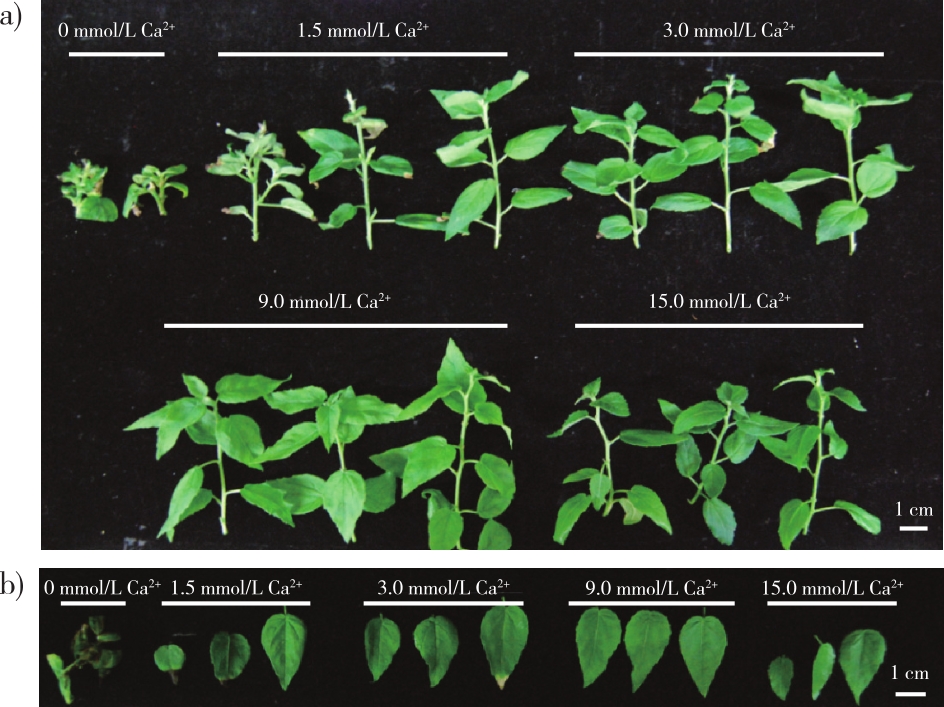【目的】木本植物生长周期长、再生能力较弱,严重制约了林木快速育种。离体培养技术突破了季节限制,可显著加速林木繁育进程。钙作为植物必需营养元素和胞内第二信使,参与植物生长发育的调控,但其在木本植物离体培养中的影响尚不明确。系统研究离体培养条件下钙处理对木本植物生长发育的影响,对提升林木组织培养效率和指导育种实践具有重要意义。【方法】以木本模式植物‘84K’杨(Populus alba × P. glandulosa)无菌苗为实验材料,设置0、1.5、3.0、6.0、9.0和15.0 mmol/L的Ca2+处理,比较不同浓度Ca2+处理对无菌苗生长及不定根诱导的影响。【结果】在0~9.0 mmol/L范围内,Ca2+浓度与无菌苗长势正相关,其中6.0 mmol/L处理下植株最高,9.0 mmol/L处理植株叶片最大,故最适Ca2+浓度为6.0~9.0 mmol/L。缺钙(0 mmol/L)影响茎段顶端优势的维持,主根显著加粗并异常伸长;而高钙(15.0 mmol/L)处理则抑制整体生长,株高下降、叶片变小。研究还发现,Ca2+通过促进节间伸长而非增加节间数量来提升株高。不同培养基钙处理对茎段伸长的影响趋势一致,但响应强度存在差异。钙处理不影响不定根诱导数量,但在缺钙时,不定根显著伸长和增粗,显示根系对钙缺乏具有特异的形态响应。【结论】Ca2+以浓度依赖性方式差异调控‘84K’杨无菌苗的茎部伸长和根构型建成,适宜Ca2+浓度有助于维持顶端优势,而缺钙则促使根构型重塑。本研究初步揭示了Ca2+对杨树茎伸长和根构型重塑的差异化调控作用,为木本植物无菌苗发育及不定根诱导与伸长研究奠定理论基础。
【Objective】Woody plants typically have long growth cycles and limited regenerative capacity, which significantly restricts the efficiency of forest tree breeding. In vitro culture techniques can overcome seasonal constraints and accelerate propagation. Calcium, as an essential nutrient and a critical intracellular second messenger, plays a vital role in plant growth and development. However, its specific regulation in woody plant tissue culture remain unclear. Systematic investigation of calcium treatment under the in vitro condition is of great significance for improving tissue culture efficiency and supporting breeding strategies in forestry.【Method】We treated shoots of the woody model speices hybrid poplar ‘84K’ (Populus alba × P. glandulosa) in vitro under Ca2+ concentrations of 0, 1.5, 3.0, 6.0, 9.0 and 15.0 mmol/L. The effects of Ca2+ on shoot growth and adventitious root induction were systematically analyzed.【Results】Within the 0-9.0 mmol/L range, increasing Ca2+ concentrations enhanced shoot growth. The maximum plant height was observed at 6.0 mmol/L Ca2+, while leaf expansion was most pronounced at 9 mmol/L, indicating an optimal concentration range of 6.0-9.0 mmol/L. Complete calcium deficiency(0 mmol/L) disrupted apical dominance, resulting in shoot tip necrosis and excessive elongation and thickening of the primary root. In contrast, high Ca2+ concentration (15 mmol/L) significantly inhibited overall growth, with reduced plant height and smaller leaves. Ca2+ promoted stem elongation mainly by increasing internode length rather than node number. While the response intensity varied across different basal salts, the overall trend was consistent. Different concentration of Ca2+ treatments had no significant effect on the number of adventitious roots, but calcium deficiency led to pronounced elongation and thickening of adventitious roots, suggesting a specific root morphogenetic response to Ca2+ dificiency.【Conclusion】Ca2+ exerts concentration-dependent and tissue-specific effects on poplar in vitro. Moderate Ca2+ levels help maintain apical dominance and promote shoot elongation, while the Ca2+ deficiency triggers architectural remodeling in roots. These findings provide preliminary insights into the differential regulation of shoot and root development by Ca2+ in woody plants and lay a theoretical foundation for improving tissue culture systems and calcium-mediated molecular breeding in forestry.
 PDF(27874 KB)
PDF(27874 KB)


 PDF(27874 KB)
PDF(27874 KB)
 PDF(27874 KB)
PDF(27874 KB)
